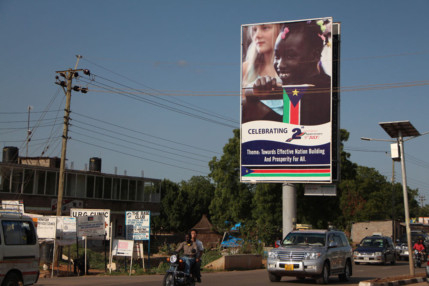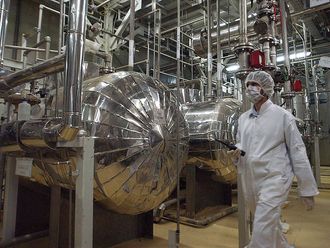
Juba: Two years ago, South Sudan seceded from Sudan and became an independent nation following decades or civil war. Tensions and fighting overshadowed the first two years of South Sudan’s independence. While two years may not be enough to overcome the issues of one of the longest civil wars in Africa, some doubt the ability of the two nations to build a stable and peaceful relationship.
In September 2012, the two countries signed the Addis Ababa agreements, laying down the foundation for cooperation in nine critical areas such as setting up a demilitarised border zone, opening the border for free movement of goods and people as well as oil transit fees.
The agreements were followed by the signing of the implementation matrix in March 2013 which laid out the way forward in implementing the agreements. But the myriad and complexity of the issues that were inherited from the civil war, coupled with ongoing internal insecurity on both sides of the border make the peace process prone to stalemate and mutual accusations.
Khartoum accuses South Sudan of arming the SPLM-North, a rebel group that operates in South Kordofan. In an interview with Gulf News, Atam Yaak Atem, South Sudan’s Deputy Minister of Information denies any linkages: “If we are having difficulties to pay salaries after stopping the oil [exports], where would we get the money to arm [the SPLM-N]. They don’t belong to us, but the fact that we used to be one movement during the war still lingers.”
However, Khartoum refuses to proceed with the implementation of the September 2012 agreements without the AU’s ruling on this issue. “We have not been able to implement the agreements because we have legitimate security concerns about the support to the SPLM-N by some elements of the [South Sudan] government. We have evidence, which we have provided to the African Union (AU), and we are waiting for the decision,” stated Magdi Ahmad Mofadal, Deputy Head of Mission of the Sudan Embassy in Juba in an interview with Gulf News.
On the other hand, Juba claims that Khartoum supports armed elements in South Sudan, which is denied by Sudan. A 2013 Small Arms Survey Report suggests that there may be evidence that David Yau Yau’s movement in Jonglei is receiving material support from Khartoum.
Yau Yau’s movement, which thrives on the growing resentment among the marginalised Murle community due to forceful disarmaments and lack of basic service delivery, has gained ground in 2012. According to the report, the extent to which the movement was armed in 2012 may not have been possible without external support.
While the AU provides the mechanisms to review the allegations by both parties in order to get the implementation of the September agreements on track, faith in the process is undermined by lack of trust, past failures to honour agreements as well as the AU’s inability to enforce them.
“Khartoum has a history of breaking agreements,” Atam said. “We have always said that war is not an option, dialogue is the choice. But of course, we deserve the right to defend ourselves when necessary”
Yet in some instances, distinguishing self defence from aggression is not clear cut either. In March 2012, the SPLA crossed the border into Sudan to occupy Heglig oil field. Heglig, called Panthau by South Sudan, is located within the current borders of Sudan. The AU condemned the attack as “illegal,” and demanded that South Sudan immediately withdraw its troops, which South Sudan did only a few days later.
But according to South Sudan, Heglig is south of the 1956 border and is therefore considered South Sudanese territory. Experts say that the current evidence whether Heglig belongs to the North or South appears inconclusive due to the lack of official documentation and displacement of people during the war. To date, there has been little progress on the border demarcation process set forth in the 2005 Comprehensive Peace Agreement.
Deadlock over Abyei continues
The status of the border region of Abyei has been another element of the peace agreement which has seen next to no progress. The referendum to decide whether Abyei should belong to Sudan or South Sudan was to be held alongside South Sudan’s referendum in 2011, but did not proceed due to disagreements over whether nomadic Arab Misseriya tribes should be allowed to participate. Including the Misseriya would tilt the odds towards Sudan’s favour.
For the past year, Sudan and South Sudan have been in a deadlock over the formation of the region’s political body, the Abyei Area Council (AAC), as set forth in the June 2012 Addis Ababa agreements. Earlier this year, Sudan imposed additional demands to increase the representation of its government in the council from 50 per cent to 60 per cent, a demand that has been rejected by South Sudan. The referendum is unlikely to proceed without the establishment of key institutions such as the AAC.
The death of Abyei Dinka Chief Kuol Deng Kuol in May this year further increased tensions. Kuol, who was paramount to the peace process, was killed during an ambush on his convoy by members of the Misseryia tribe. South Sudan has accused its northern neighbour of being responsible, but Khartoum has denied any involvement in the assassination, and has created a commission to investigate the incident.
The risk of these incidents igniting fighting between the two parties is serious. They further cement distrust and discredit painstakingly negotiated agreements, eroding the very purpose of the peace dialogue.
Simona Foltyn is a freelance writer who has lived and worked in both Sudan and South Sudan. She also worked for the UN.












